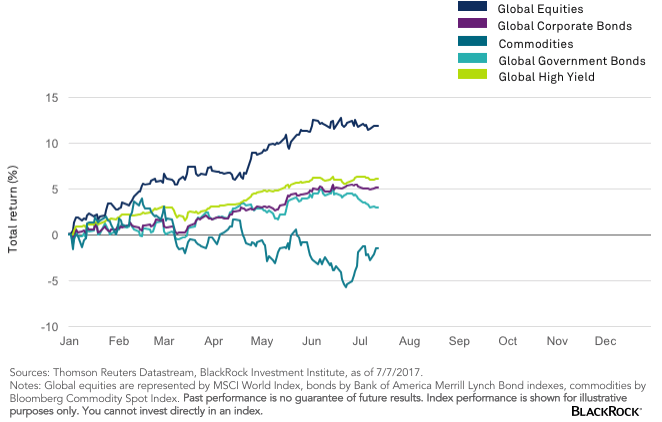by Russ Koesterich, Portfolio Manager, Blackrock
So far it has been a great year—at least for paper assets. Long-dated U.S. Treasuries are up 4%, high yield 6%, the S&P 500 nearly 10% and emerging market equities over 17% in U.S. dollar terms. But it has been a less inspiring year for commodities.
Half-time report
2017 Asset Performance
Some investors are wondering whether softer commodity prices represent a sign of economic deceleration—along with a flatter yield curve and decelerating inflation—or an even bigger threat. For now, I think the answer is no. Here are three reasons why:
Commodities prices have witnessed significant divergence
Not all commodities have done poorly year-to-date. The weakness in some commodity indexes has been largely about energy. Oil prices are down nearly 20%; natural gas has done even worse. However, metals have performed better along with select agricultural commodities, notably corn and wheat.
The drop in energy has been as much about supply as demand
It is true that oil demand has slipped: The International Energy Agency (IEA) puts worldwide crude demand in the first quarter at 96.45 million barrels per day (bpd), down from over 97.60 million bpd at the end of 2016. However, compounding the problem has been a rebound in supply. Two OPEC countries in particular have surprised with higher production: Libya and Nigeria. Libyan production has quadrupled from last fall’s low, while Nigerian production has risen by more than 300,000 bpd since last August. At the same time, U.S. shale producers continue to demonstrate remarkable resiliency in the face of lower prices. U.S. domestic crude oil production has climbed by almost 600,000 bpd since late December and by nearly one million bpd from last fall’s lows.
Cyclical commodities are doing well on the manufacturing rebound
While precious metals are having a mixed year—gold up, silver down, platinum flat—industrial metals have generally been strong. The Journal of Commerce (JOC) Industrial Metals Index is up approximately 6% year-to-date. This is consistent with the global improvement in manufacturing surveys. For example, in the U.S. the Institute for Supply Management (ISM) Manufacturing Index has risen three points since December and is now close to a three-year high. Even more encouraging, the new orders component has been particularly strong. This is important as the level of new orders correlates closely with industrial metal gains. To the extent manufacturing surveys—and particularly new orders—remain high, industrial commodities are more likely to be supported.
For now investors can look past softness in commodity indexes. What would change my mind? Two things in particular would cause me to worry: a sharp downturn in leading economic indicators or substantially tighter financial conditions. For now, the former is not visible. On the latter, while the Federal Reserve is tightening and the European Central Bank is musing about less accommodation, financial conditions remain easy thanks to still low interest rates, a weak dollar and tight credit spreads. Should these conditions remain in place, investors can, for now, look past the challenges in the commodity sector.
Russ Koesterich, CFA, is Portfolio Manager forBlackRock’s Global Allocation team and is a regular contributor to The Blog.
Copyright © Blackrock
















